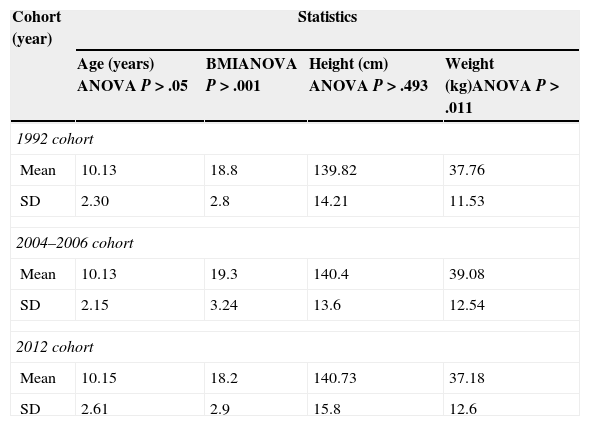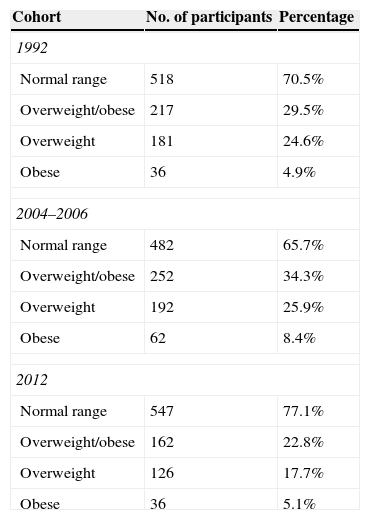Spain has one of the highest prevalences of childhood overweight and obesity in Europe. The frequency of excess weight has increased considerably between 1985 and 2000, although it seems to have stabilised in the past 10 years.1
In order to fight this emerging epidemic, we need to monitor the secular trends of obesity by means of population studies or surveys. This surveillance must be done in reference to standardised consensus definitions of terms such as obesity, overweight and normal weight specific for age and sex.2
We analysed the trends in overweight and obesity in children 5–14 years of age over three sequential time intervals corresponding to years 1992, 2004–2006 and 2012.
We performed a cross-sectional observational study, requesting the participation of all the students enrolled in 3 elementary and 2 secondary schools in Oviedo.
Weight was measured to the nearest 100g using a mechanical scale. Height was measured with a Leicester® stadiometer to the nearest 0.1cm. We based our definitions of overweight and obesity on mean percentiles calculated according to the sex- and age-specific BMI criteria of the International Obesity Task Force (IOTF).
We measured 734 children in 1992, 735 between 2004 and 2006, and 709 in 2012, out of a total of 1100. The final sample consisted of 2178 individuals. We did not find differences in the distribution by age or by sex (Table 1).
Descriptive statistics of the 3 cross-sectional studies done in 1992, 2004–2006 and 2012.
| Cohort (year) | Statistics | |||
|---|---|---|---|---|
| Age (years) ANOVA P>.05 | BMIANOVA P>.001 | Height (cm) ANOVA P>.493 | Weight (kg)ANOVA P>.011 | |
| 1992 cohort | ||||
| Mean | 10.13 | 18.8 | 139.82 | 37.76 |
| SD | 2.30 | 2.8 | 14.21 | 11.53 |
| 2004–2006 cohort | ||||
| Mean | 10.13 | 19.3 | 140.4 | 39.08 |
| SD | 2.15 | 3.24 | 13.6 | 12.54 |
| 2012 cohort | ||||
| Mean | 10.15 | 18.2 | 140.73 | 37.18 |
| SD | 2.61 | 2.9 | 15.8 | 12.6 |
BMI, body mass index; SD, standard deviation.
The overall prevalence of obesity was significantly higher in the 2004–2006 period compared to 1992 (8.4% vs 4.9%; P=.01). However, there was a decrease in the overall prevalence of obesity between the 2004–2006 period and 2012 (8.4 vs 5.1%; P=.01).
We found statistically significant differences between cohorts in the overall prevalence of overweight. We observed a decline of 8.2% between the 2004–2006 period and 2012 (25.9% vs 17.7%; P=.0001), and a decline of 6.9% between 1992 and 2012 (24.6% vs 17.7%; P=.004), respectively (Table 2).
Prevalence of childhood overweight and obesity in Oviedo in years 1992, 2004–2006 and 2012.
| Cohort | No. of participants | Percentage |
|---|---|---|
| 1992 | ||
| Normal range | 518 | 70.5% |
| Overweight/obese | 217 | 29.5% |
| Overweight | 181 | 24.6% |
| Obese | 36 | 4.9% |
| 2004–2006 | ||
| Normal range | 482 | 65.7% |
| Overweight/obese | 252 | 34.3% |
| Overweight | 192 | 25.9% |
| Obese | 62 | 8.4% |
| 2012 | ||
| Normal range | 547 | 77.1% |
| Overweight/obese | 162 | 22.8% |
| Overweight | 126 | 17.7% |
| Obese | 36 | 5.1% |
We grouped participants in two categories according to the age of onset of puberty: children (<11 years) and adolescents (>11 years). In children, the prevalence of obesity was significantly lower in the 2012 cohort (8.8% in 2004–2006 vs 4.1% in 2012; P=.021), while no significant differences were observed between adolescent cohorts.
When we stratified the data by sex, the prevalence of obesity decreased significantly from 9.6% in the 2004–2006 period to 5.4% in 2012 in boys, but not in girls (7.1% vs 4.6%, P=.17), in whom the difference was not statistically significant. In the 2012 cohort, the prevalence of obesity was significantly higher in boys, especially in the preadolescent age group, than in girls.
The prevalence of childhood overweight has increased in nearly every country for which data are available. A systematic review published in 2006 on the secular trends of childhood obesity concluded that its prevalence had increased in the past 2 or 3 decades in nearly every developed country, especially in urban areas.3
We described an increase in children's weight between 1992 and 2006,4 but to our knowledge the decreasing trends observed in our study have not been described before in Spain. The prevalence of childhood obesity in Oviedo has decreased considerably in the past 7 years, showing a clear trend towards a sharper decline in males in older age groups. In any case, generalising the findings of our study may not be possible, as our sample came from a middle-class population from a specific geographical area.
Similar trends have been observed in the United States, where the increase in the prevalence of childhood overweight and obesity has been documented extensively since the 1960s.5
We do not know what has caused this marked change in trend.
Since 2009, efforts had been made to educate children on healthier alternatives, introducing better-quality foods in the lunchroom menus and vending machines of Oviedo schools, and expanding school sports and physical activity programmes to weekends and summers.
In recent years, the recommendations of the WHO and UNICEF on the optimal duration of breastfeeding that call for delaying the introduction of solids until 6 months of age, maintaining exclusive breastfeeding until 6 months of age and continued breastfeeding until 2 years of age or more, may be contributing to the decline in the prevalence of childhood obesity.
Although obesity has become a world epidemic, our understanding of this condition in childhood is limited by a lack of representative data from different countries for their comparison, as well as by the different criteria used to define it.
The IOTF has developed charts for an international growth standard that allows the comparison of prevalences across the world. There is evidence that the IOTF classification has a high specificity but a low sensitivity, although many countries continue using their own national charts, including Spain and the United States, where the standards in use were developed from data acquired in nationwide surveys.
At present we do not have a general consensus standard to classify overweight and obesity in children and adolescents. The use of universal criteria for classifying obesity could help make international comparisons.
We want to thank Dr Juan José Díaz Martín for giving us access to the data of years 1992 and 2004–2006, and for supervising our study.
Please cite this article as: Llada Suárez R, del Fresno Marqués L, Díaz Martín JJ, Málaga Guerrero S, Rey Galán C. Obesidad en Oviedo: prevalencia y tendencias temporales de 1992 a 2012. An Pediatr (Barc). 2015;82:363–365.
Previous presentations: Oral presentations at the SCCALP Spring Meeting, April 12–13, 2013; Palencia, Spain; as well as the XX Congress of the SEGHPN; May 23–25, 2013; Málaga, Spain.






